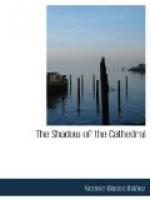The Perrero examined the lower stalls, ferreting out among the Gothic relievos the discoveries enjoyed by his unwholesome curiosity. This first row of stalls, almost on a level with the ground, were occupied by the inferior clergy, and were anterior by half a century to the upper stalls; but in those fifty years art had made a great stride, from the hard and rigid Gothic to the flowing lines and good taste of the Renaissance. They had been carved by Maestre Rodrigo at the time when Christian Spain, roused to enthusiasm, was helping the Catholic kings with all its strength to complete the reconquest. On the backs of the stalls, and on the entablature of the frieze fifty-four carved pictures represented the principal incidents of the conquest of Granada.
The Tato did not look at these carvings of walnut or oak, with troops of horsemen and companies of soldiers scaling the walls of Moorish towns. What interested him most were the arms of the stalls, the handrails of the steps leading to the upper seats, and the salients dividing the stalls which served to rest the head, all covered with animals, grotesque beings, dogs, monkeys, big birds, friars, and little birds, all in difficult postures, some beautiful, some obscene. Hogs and frogs wound themselves up together in inextricable tangles, monkeys with ignoble gestures were mixed up with interlaced birds in never ending variety—it was a world of caricatures of voluptuousness, of monkey-like actions and satirical suggestions, in which appeared carnal passion with the most grotesque animal grimaces.
“Look here, uncle. Is not this capital—it is far the best.”
And the Tato showed Gabriel the little chubby figure of a preaching friar with enormous donkey’s ears.
When they came out of the choir Gabriel spied the Chapel-master close to the fresco of Saint Christopher. He had just emerged from a little door close to the giant, which led by a circular staircase to the musical archives. He was carrying under his arm a big book with dusty pages which he showed to Gabriel.
“I am taking it upstairs. You shall hear something out of it; it is worth the trouble.”
And turning his eyes from the book to the little door close by he exclaimed:
“Ay! these archives, Gabriel, how it pains one! Each time I visit them I come out sadder. The vandals have been at work there; nearly all the music books have pages torn out, pieces cut out wherever there was an illuminated letter, a vignette or anything pretty. The senor canons do not care for music, neither do they understand it, and they are incapable of devoting a few pesetas so that it might be heard on festival days. It is quite enough for them to walk in procession to some piece of Rossini’s; and as far as regards the organ, all they care about is that it must play slowly, very slowly. The slower it plays, the more religious they think it, even though the organist may be playing a Habanera.”




